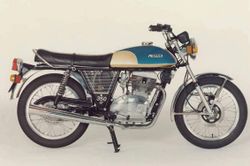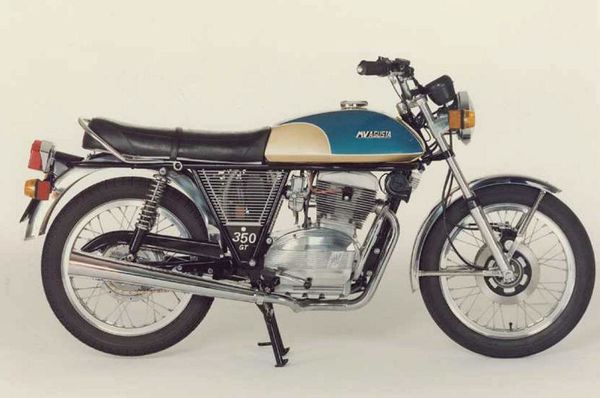MV Agusta 350 Turismo Ipotesi
 |
|
| MV Agusta 350 Turismo Ipotesi | |
| Manufacturer | |
|---|---|
| Production | 1976 - 77 |
| Engine | Four stroke, 20° inclination parallel twin cylinder, OHV engine with rocker support |
| Compression ratio | 9.2:1 |
| Ignition | Electronic |
| Transmission | 5 Speed |
| Frame | Single beam tubular and pressed steel |
| Suspension | Front: Telescopic hydraulic fork Rear: Swinging arm fork with adjustable hydraulic shock absorbers |
| Brakes | Front: 2x 230 mm hydraulic discs Rear: 200mm Drum |
| Front Tire | 2.75-18 |
| Rear Tire | 3.25-18 |
| Wheelbase | 1300 mm / 51.1 in |
| Weight | |
| Fuel Capacity | 19 Liters / 5.0 US gal |
| Manuals | Service Manual |
Engine[edit | edit source]
The engine was a Air cooled cooled Four stroke, 20° inclination parallel twin cylinder, OHV engine with rocker support. The engine featured a 9.2:1 compression ratio.
Drive[edit | edit source]
Power was moderated via the Wet multiple plate clutch.
Chassis[edit | edit source]
It came with a 2.75-18 front tire and a 3.25-18 rear tire. Stopping was achieved via 2x 230 mm hydraulic discs in the front and a 200mm Drum in the rear. The front suspension was a Telescopic hydraulic fork while the rear was equipped with a Swinging arm fork with adjustable hydraulic shock absorbers. The 350 Turismo Ipotesi was fitted with a 19 Liters / 5.0 US gal fuel tank. The wheelbase was 1300 mm / 51.1 in long.
Photos[edit | edit source]
Overview[edit | edit source]
MV Agusta 350 Turismo Ipotesi
Derived from the Ipotesi, it presented different handlebars to improve the bikes touring capabilities. It also had a different color scheme with a gold and blue gas tank. Review
MV's concept of a sports single is robustly efficient but
does the name make up for the bike and its price?
"OKAY, SO YOU'RE RIDING an MY 350 and MY do win the 350 world championship, but the bike you paid $1200 for has a frame like a prewar Velocette and a motor that looks like a split single Jawa two-stroke." In a way he was correct; the makers do stick their rectangular badge on top of the tank boasting the number of world championships they have won. It may be all right for the glamorous 750 but it is completely out of place on this 350 a bike as far removed from the modern racing bike design as it is possible to imagine. The basic machine was designed in the early fifties and apart from the brakes, suspension and pretty trimmings, is unchanged. The motor looks mid-fiftyish and resembles the old Jawa, just as the observer said. The seat, tank and front end look attractive but they do little to alter the basic image. But the fact is that the motor is sufficiently powerful and durable enough to last for many years to come, and the frame is certainty stiff enough. Such is the MY 350; it is a well-buiit little middleweight with racey lines around an old design that will set you back a cool $1200. We picked up the bike from Bob Jane's new Footscray shop in Melbourne, and took it straight out on the nearby Geelong Road which is a fast multi-laned highway. Like the 750, the riding position is strictly racing but a good racing one for the hand and foot controls are perfectly located. The few miles through the suburbs confirmed what anyone can expect from rearsets and clip-ons fun for the first few minutes followed by a gradual feeling of discomfort. Mixing it with the fast-moving, inter-city, highway traffic lifted the weight from the wrists and the 70 mph ride became enjoyable. At this speed a fair amount of vibration can be felt through the pegs and bars. It won't worry riders, but it murdered the little CEV instruments. They're the size of 20 cent pieces, and their lack of accuracy is laughable. Not only are they plus or minus accurate readings at any time (as our speed trap proved later) but they are slow to react.
A four-stroke twin, but by curious coincidence the powerplant resembles a much earlier two-stroke. The 350 has undeniably racey lines.
At the end of the morning with more than 100 miles of city and
highway riding completed we arrived at Calder Raceway to run performance
figures.
Revving the engine to eight grand produces lively acceleration
through the close-ratio gears. Down the long straight and into Repco corner
the braking was left quite late a mistake not to be repeated!
The front stopper is a grabber of the first order when the
lever is pulled hard. There is not a trace of progression, just one almighty
dig-in of the front tire as the forks slam down to full movement. Presumably
the only way to cure this (although we didn't get the opportunity to prove it)
would be to taper the leading edges of the brake linings.
Leaning it deep into Repco showed the clearance to be good and
the quick burst up through the gears along the back straight soon brought us
into the esses. After taking the righthander and making a short bit
oi' acceleration for the next bend the throttle could just be
closed to utilise surprisingiy good braking effect from the engine.
Throwing the bike down into the only left hander of the
circuit caused one almighty scrape from the centre stand, causing involuntary
straightening up which put the bike wet! off on the right hand side of the
track for Gtoweave corner. It needed a full track wide S movement to approach
the next right hand bend from the correct angle.
Down the main straight again and on to the second lap, where a
rider could rest the front part of his bucket helmet on the tank cap to
achieve the excellent streamlining this 350 offers. We soon forgot the clutch
and going up and down the box merely became a few short but firm prods on the
lever to maintain the revs between six and eight thousand. Under these
conditions the bike returns just under 50 mpg and even after many laps no oil
could be seen from any of the engine joints.
Though the machine lapped the circuit quite fast for a 350 it
did so only because of its tight weight. The actual pick-up is quite sluggish
by modern standards and it takes some time before the full 28 horses can be
used to their full advantage through the 300 pound bike.
We are surprised just how stiff the frame is, but the makers
could have obtained the same amount of rigidity by using modern double loop,
small diameter, light wall tubing in a triangulated layout. The result would
be a substantial weight saving as well as looking a bit more contemporary than
the existing configuration.
Admittedly a single front tube looks alright but the huge
swinging arm mounting plates and those large unsightly bo omerang-cum-banana
oval tubes up to the top of the units are not really acceptable nowadays.
As an about-town ride the 350 S is certainly lively
The controls are also Tommaselli (same as the 750) but the
alloy instrument panel holds badly inaccurate instruments.
and likes being thrown around, but some people could easily
get tired of the out and out racing position and its hard, but
beautifully-shaped seat. Starting is reasonably easy from the touring type
Del'orto carbs even though the lever is on the left side. We found neutral
hard to find sometimes and the small diameter 6 volt headlight only suitable
for lit roads.
On the mechanical side the bike should last a long time
because it is hand-built out of substantial components. The front end is
exceptionally strong with efficient forks holding the big 8 inch brake,
Sanremo alloy rim, stainless guard and those immaculate Tommaselli controls.
That old-looking engine could give its best for many years if
an owner fits air filters on the twin carbs.
The chromium plating on the exhausts is thin and the bracket
that hotds the silencer on to the frame will rust up inside a couple of
months. However, this would be the only complaint about the quality, as the
remainder of the welds, fittings and deep and extensive red paintwork is
excellent.
The bike attracted a fair bit of attention whenever it was
parked. Why, we were not too sure was it the unusual lines or the
distinctive red paint? So we used some black masking tape to cover the MY
badges on the tank and the "Champion of the World" rectangle by the filler
cap.
It became just another bike in the parking lot, which just
happened to be red with clip-on bars. No one bothered our rider with questions
about MVs and their prices, no one even took any notice of the machine must
be a moral there somewhere. *
Source
| Make Model | MV Agusta 350 Turismo Ipotesi |
|---|---|
| Year | 1976 - 77 |
| Engine Type | Four stroke, 20° inclination parallel twin cylinder, OHV engine with rocker support |
| Displacement | 349 cc / 21.3 cu-in |
| Bore X Stroke | 63 x 56 mm |
| Cooling System | Air cooled |
| Compression | 9.2:1 |
| Lubrication | Wet sump |
| Induction | 2x 24mm Dell'Orto carburetors |
| Ignition | Electronic |
| Starting | Kick |
| Max Power | 28 hp / 20.8 kW @ 7600 rpm |
| Clutch | Wet multiple plate clutch |
| Transmission | 5 Speed |
| Final Drive | Chain |
| Frame | Single beam tubular and pressed steel |
| Front Suspension | Telescopic hydraulic fork |
| Rear Suspension | Swinging arm fork with adjustable hydraulic shock absorbers |
| Front Brakes | 2x 230 mm hydraulic discs |
| Rear Brakes | 200mm Drum |
| Front Tire | 2.75-18 |
| Rear Tire | 3.25-18 |
| Dimensions | Length: 1960 mm / 77.1 in Width: 620 mm / 24.4 in |
| Wheelbase | 1300 mm / 51.1 in |
| Weight | 160 kg / 352 lbs |
| Fuel Capacity | 19 Liters / 5.0 US gal |
